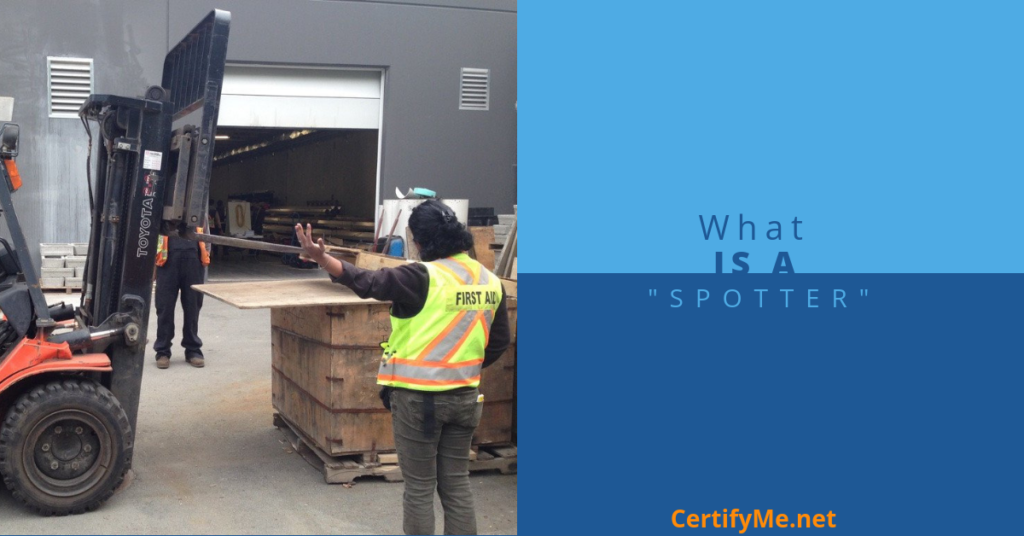What is a Spotter?
Posted by: admin on April 15, 2022
 When operators fail to handle a forklift properly, it can tip over. For example, driving with too much weight or an unbalanced load can cause a tip-over. Extending the forks too far can also cause a tip-over.
When operators fail to handle a forklift properly, it can tip over. For example, driving with too much weight or an unbalanced load can cause a tip-over. Extending the forks too far can also cause a tip-over.
As a result of these and other operator mistakes, forklifts can cause serious damage. That’s why OSHA recommends having a spotter work in concert with the truck operator.
But what is a spotter, and what are some common forklift spotter responsibilities? This article will explain everything you need to know about forklift spotters. CertifyMe.net can also explain everything required to gain OSHA compliance for your forklift drivers. So whether you need to get new employees up to speed or provide renewal training for veteran lift operators, CertifyMe.net is the only training solution you need! Sign up now!
Forklift Spotter Responsibilities
A forklift spotter acts as a second pair of eyes and ears for the driver. The spotter stands near the forklift and feeds information to the driver. That way, forklift spotting ensures that the driver can receive information about things they are unable to see or hear.
Spotters are sometimes referred to as observers, signalers, and guides. Meanwhile, spotter requirements vary based on the job. For example, warehouse forklift spotters have different considerations and hazards to deal with than a heavy equipment spotter.
Regardless of what they’re called or where they work, forklift spotters are key contributors. With spotters in place, your business is well-equipped to prevent forklift accidents.
What is a Spotter’s Primary Duties & Requirements?
Forklift spotting is a complex job, and those who want to become spotters must complete a comprehensive training program. This is due to the fact that forklift spotters have many responsibilities.
A forklift spotter ensures that a truck operator lifts a load properly and moves it to the correct location. This includes ensuring that the load is balanced, so it won’t fall off a lift. Once the forklift is being driven, the spotter ensures that it doesn’t hit any people or objects as well.
Forklift spotter job duties include:
- Directing a travel route when a driver’s vision is blocked.
- Directing the positioning of a load on the forks while it is being lifted.
- Watching for drop-offs, overhead wires, piping, and other hazards when lifting and driving a lift.
- Keeping pedestrians away from hazardous areas and travel paths.
- Following a forklift on roads to protect the lift and other vehicles.
Indoor work sites can be noisy, to the point where excess noise can make it tough for forklift operators to communicate with their coworkers and managers. Outside, spotters use signals that prove to be better options than voice commands. Before starting a job, a spotter needs to ensure the operator understands the signals that will be used.
Forklift Spotting Risks
Although forklift spotting may seem simple, it can be risky. Back-over incidents in which a forklift operator inadvertently strikes a spotter can be fatal. But, a spotter who understands the risks associated with spotting a forklift is well-equipped to avoid these incidents.
Keeping the lines of communication with a forklift operator can be beneficial, too. If a lift spotter identifies any dangers, he or she can quickly notify the operator. This allows the operator to minimize the risk of accidents and avoid putting the spotter or others in danger.
Proper forklift spotter training is all about eliminating and reducing risk. Forklift spotter safety requires a common understanding between the forklift driver and the spotter. Once the lines of communication are established and adhered to, there isn’t any task that will be left undone!
Can Anyone Become a Forklift Spotter?
Much in the same way that certification is required to operate a forklift, a lift spotter needs proper training. Because, if a spotter learns the ins and outs of helping an operator maneuver a forklift, he or she can minimize the risk of lift accidents and injuries across a job site.
Generally, forklift spotters can benefit from operator training as well. They can use the training to learn the duties of spotters and operators alike. Plus, the training gives them an opportunity to ask questions about forklift spotting and gain the insights they need to become expert spotters.
A Closer Look at Forklift Spotter Training
OSHA regulations often require a spotter to be at a job site. Regardless of OSHA requirements, it is usually a good idea to have a trained spotter on hand.
Forklift spotter training involves learning to drive a forklift, and the best spotters often double as forklift operators. On the flip side, the best drivers are often the best spotters.
Also, forklift spotter training covers load-lifting techniques. On the job, spotters tell operators when and how to lift a load. Operators know how to do this, but they don’t always have the best view of the load. Having a second pair of eyes can make loading and lifting safer and easier. Having a spotter is vital when a load is on a high rack, too. In this scenario, even a small mistake could cause the load to fall and result in an accident, injury, or fatality.
The spotter’s job is to keep those working around the forklift safe. But, spotters are also at risk, and they need to prioritize workplace safety.
Forklift Spotter Safety Tips
Best practices for forklift spotter safety include:
1. Ensure spotter and driver agree on hand signals.
Before starting a task, the forklift driver and spotter should finalize a common hand signal system for actions like slow, stop, lower, raise, etc.
2. Use two-way radio communication if required.
There are times when the forklift spotter and driver can’t clearly see each other. Walkie-talkies and other two-way radios are ideal for communicating over distances.
3. Maintain visual contact between spotter and driver.
This step helps eliminate accidents from the start, especially when the forklift is backing up. If visual contact is lost, walkie-talkies or other radio communication is recommended (see #2 above).
4. Use traffic control measures to account for pedestrians.
Signs, cones and other right-of-way indicators are helpful in effectively routing pedestrian traffic out of danger zones. Check out our helpful article on forklift right of way for more information.
5. Avoid multitasking.
More distractions means more chance of an accident or injury. Do not use mobile phones, headphones, or other items that could distract a spotter.
6. Use personal protective equipment (PPE).
Spotters should always wear brightly colored, easy to recognize clothing. Wear highly visible clothing, especially at night. Gloves, hats, goggles or other PPE might be required for your particular job. Always review PPE requirements BEFORE starting the job.
7. Use forklift spotter hand signals.
Common signals to learn and know include back up, move forward, stop, slow down, turn left, turn right, and more. These signals should be agreed upon before starting the jobs (see #1 above).
What’s more, your company should also have regular spotter meetings to review key safety aspects. This meeting could cover:
- Destination of cargo
- Hand signals
- Existing safety concerns
- Timeline of job
- Details about forklifts being used
- Pre-site job inspection for driver and spotter
- And other common issues.
Furthermore, if a spotter has never operated an aerial lift or other heavy equipment, he or she should discuss any blind spots with the driver. This will help prevent the spotter from accidentally walking into a blind spot.
Along with the aforementioned safety tips, forklift spotters should also use hand signals to communicate with drivers.
Forklift Spotting for Heavy Equipment
Spotters aren’t just for warehouses and indoor distribution centers. Heavy equipment spotters are essential for things like construction, heavy-duty maintenance, and more. The need for forklift spotters extends beyond indoor jobs. Many outdoor jobs, such as construction sites, can benefit from having spotters, and any job that uses aerial lifts, earthmovers, and other heavy equipment should have a spotter.
Spotters are essential when working around overhead structures, steel columns, and live power lines. Tight spaces and narrow paths can make it tough to work, and a travel route may include rough terrain or temporary access roads that are difficult to navigate. In these cases, a spotter can improve safety and help prevent accidents.
Heavy equipment spotters have the same basic duties as forklift spotters. They help guide aerial lift and equipment operators when they are moving their vehicles. Heavy equipment spotters also scan the ground to look for trip or fall hazards and ensure workers stay clear of travel paths.
A forklift spotter and operator should engage in safety planning before they start a job. First, they should agree on hand signals and review the planned travel route.
CertifyMe.net: Your #1 Option OSHA Forklift Spotter Safety & More!
Now that you know what a forklift spotter is, along with some of the roles & responsibilities that go along with heavy equipment spotters and more, it’s a great time to assess your company’s current compliance situation. Aside from forklift spotter safety and other related tasks, is your firm up to speed with general OSHA requirements? If not, let CertifyMe.net be your reliable “spotter” – and comprehensive provider – of safety training and certification!
At CertifyMe.net, we offer a training program to teach workers how to safely use a forklift. Our training program complies with OSHA regulations, and it allows employees to gain the insights they need to safely spot, operate a forklift, and identify on-the-job hazards. It also enables workers to engage with forklift safety experts, ask questions, and learn what it takes to minimize the risk of workplace accidents, injuries, and fatalities. From forklift spotter responsibilities to other critical safety tasks, we’ll ensure your company has the OSHA approved training you need!
CertifyMe.net is here to answer all your questions related to what is a spotter, plus discuss our forklift safety training program. To learn more or to sign up for our program, please contact us online or call us today at 1-888-699-4800.
Welcome to CertifyMe.net
CertifyMe.net has offered online forklift certification since 1999. With Our Convenient online program. your employess can earn their certification in an hour or less.
Browse Online Certifications:
This low-cost program can be compeleted anytime, anywhere!






